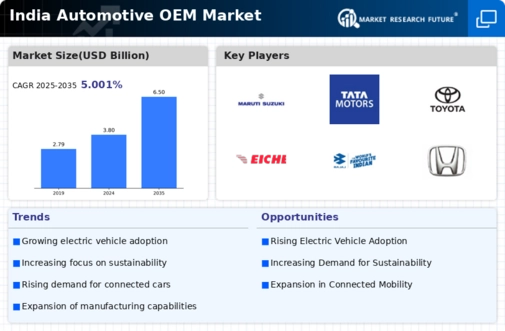Government Initiatives and Policies
The automotive oem market in India is significantly influenced by government initiatives aimed at promoting manufacturing and innovation. Policies such as the Production-Linked Incentive (PLI) scheme encourage local production, potentially increasing the market's competitiveness. The government has set ambitious targets for electric vehicle adoption, aiming for 30% of total vehicle sales to be electric by 2030. This push not only stimulates demand but also encourages OEMs to invest in research and development. Furthermore, the implementation of stricter emission norms is likely to drive innovation in cleaner technologies, thereby reshaping the automotive oem market landscape. As a result, OEMs are expected to adapt their strategies to align with these evolving regulations, which could lead to a more sustainable and technologically advanced market environment.
Sustainability and Environmental Concerns
Sustainability has emerged as a critical driver in the automotive oem market, as consumers and regulators alike prioritize environmentally friendly practices. The growing awareness of climate change and pollution is prompting OEMs to adopt sustainable manufacturing processes and materials. For instance, the use of recycled materials in vehicle production is gaining traction, with some manufacturers reporting a reduction in carbon footprint by up to 30%. Additionally, the automotive oem market is witnessing an increase in the development of hybrid and electric vehicles, aligning with global sustainability goals. This shift not only meets regulatory requirements but also appeals to environmentally conscious consumers, potentially expanding market opportunities. As sustainability becomes a core focus, OEMs are likely to innovate further, enhancing their competitive edge.
Technological Advancements in Manufacturing
Technological advancements are playing a pivotal role in transforming the automotive oem market in India. The adoption of Industry 4.0 technologies, such as automation and artificial intelligence, is enhancing production efficiency and reducing costs. For instance, the integration of robotics in assembly lines has been shown to improve precision and speed, potentially increasing output by up to 20%. Moreover, the use of data analytics allows OEMs to optimize supply chain management, thereby minimizing delays and enhancing customer satisfaction. As manufacturers increasingly embrace these technologies, the automotive oem market is expected to become more agile and responsive to market demands. This shift not only improves operational efficiency but also positions OEMs to better compete in a rapidly evolving landscape.
Expansion of Electric Vehicle Infrastructure
The expansion of electric vehicle (EV) infrastructure is a crucial factor influencing the automotive oem market in India. The government and private sector are investing heavily in charging stations and battery swapping technologies, which are essential for supporting the growing EV market. Recent reports indicate that the number of public charging stations is expected to increase by over 200% in the next three years. This infrastructure development is likely to alleviate range anxiety among consumers, thereby boosting EV adoption. As a result, OEMs are encouraged to expand their electric vehicle offerings, aligning with the increasing consumer demand for sustainable transportation options. The automotive oem market is thus poised for transformation, driven by the synergy between vehicle production and the necessary supporting infrastructure.
Rising Consumer Demand for Personal Mobility
In recent years, there has been a notable shift in consumer preferences towards personal mobility solutions, which is reshaping the automotive oem market. The increasing urbanization in India, coupled with a growing middle class, has led to a surge in demand for personal vehicles. According to recent data, the passenger vehicle segment is projected to grow at a CAGR of approximately 10% over the next five years. This trend indicates a robust appetite for personal mobility, prompting OEMs to enhance their offerings. Additionally, the desire for safety features and advanced infotainment systems is influencing purchasing decisions, compelling manufacturers to innovate. As a result, the automotive oem market is likely to witness a diversification of product lines to cater to these evolving consumer preferences.



















Leave a Comment